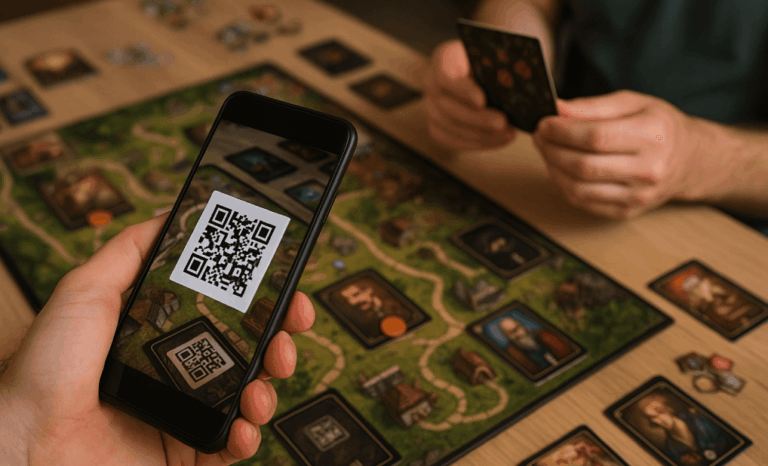The world of tabletop games has evolved far beyond cardboard and dice. Today, more designers are blending analog charm with digital power, often through a small but mighty tool: the QR code. These scannable squares are transforming gameplay by adding rich layers of interactivity, surprise, and convenience. Whether you’re a casual player or a hardcore enthusiast, QR codes in board games can make your next game night more immersive, dynamic, and fun.
Adding interactivity without cluttering the table
Board games are tactile by nature. Players love the feel of cards, tokens, and miniatures. But there’s a limit to how much content and complexity you can pack into a single box. That’s where QR codes shine, enhancing the overall gaming experience . With just one scan, players can access hidden missions, animated videos, rule clarifications, or even interactive puzzles without bogging down the physical components.
Example: In Chronicles of Crime, players scan QR codes on cards to gather clues and interview suspects. The physical cards remain minimal, but the story unfolds dynamically through your phone or tablet.
This blend of physical and digital worlds enhances the experience without overwhelming it. The board stays clean, the content stays deep.
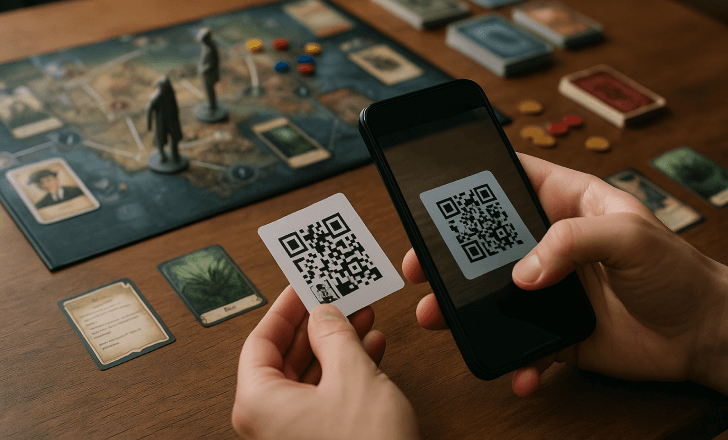
Boosting storytelling and surprise elements
Story-driven games thrive on suspense and progression. However, printed components can spoil plot twists or limit branching paths. QR codes allow game designers to keep secrets until the moment they’re meant to be revealed, which can help provide players with unexpected surprises . Scan a code, and suddenly you’re reading a new journal entry, hearing a character’s voice, or watching an event unfold on screen.
This is about deepening the emotional impact of story beats. QR codes let designers craft surprise moments that feel personal and dynamic, not canned or predictable.
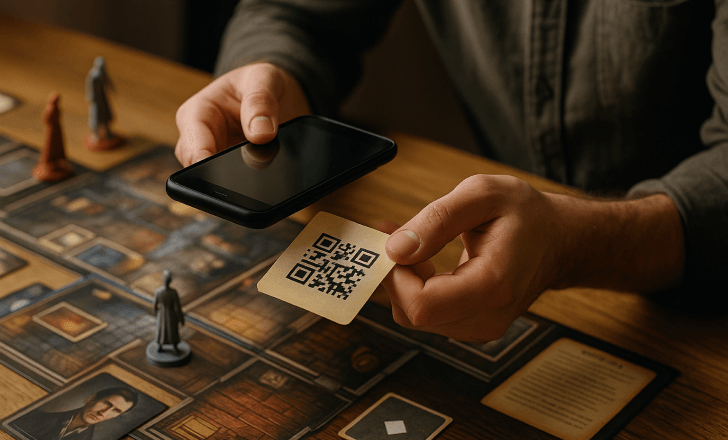
Helping new players get started faster
If you’ve ever opened a new board game and been intimidated by a rulebook thicker than a paperback novel, you’re not alone. QR codes are helping reduce that barrier. Scanning a QR code can launch a short tutorial video with clear instructions , guide you through setup, or even let you play a simplified version of the game to learn by doing.
Some publishers are now including QR-based onboarding experiences that adapt based on your pace. No more flipping back and forth through dense manuals; you get the help you need when you need it.

Making game updates and expansions easier
Traditionally, once a game ships, it’s frozen in time. Any balance tweaks, errata, or add-ons require a whole new print run. However, with QR codes, designers can update additional content dynamically. A quick scan can direct players to a revised version online if a particular card becomes unbalanced or confusing.
This flexibility also opens the door for living games that evolve over time. Think of it as DLC for your tabletop. Bonus missions, alternate endings, or holiday-themed content can be added instantly without new physical materials.
How can QR codes streamline scoring and game management?
QR codes can simplify the math for games with complex scoring systems or variable win conditions. Some games now include scannable sheets that take you to a scoring calculator or companion app that tallies data and points for you. This reduces errors, saves time, and keeps the endgame smooth and satisfying.
Beyond points, QR systems can manage inventories, player logs, or campaign progression over multiple sessions, especially useful in legacy-style games.
Can QR codes replace apps in board games?
Short answer: not exactly, but they’re often a more innovative alternative.
While many modern games come with companion apps, QR codes offer a more flexible, modular option. Instead of being locked into a whole app experience, players can scan only what they need and when needed. This keeps the digital layer optional and lightweight, which is especially important for players who value the tabletop-first feel.
Also, QR codes are platform-agnostic. There are no downloads, updates, or concerns about compatibility. Just scan and go.
Are QR codes right for all board games?
Not every game needs a digital boost. Abstract strategy games or party games often thrive on simplicity and immediacy. But QR codes offer a low-cost, high-impact way to expand what’s possible for titles involving narrative, exploration, or campaign elements.
And for game designers, they provide a chance to iterate, experiment, and personalize without inflating production costs. A game can have printed components for the base experience, with optional QR-linked enhancements for those who want more depth.

How can designers use QR codes without ruining immersion?
The key is subtlety. QR codes work best when they’re seamlessly integrated into the game’s visual design. Instead of slapping black-and-white squares on everything, designers are embedding them into artwork (signs, maps, or props) so they feel like part of the world.
Smart use also means setting expectations. If QR scanning is optional or enhances but doesn’t gate progress, players can choose how much tech they want to engage with.

What are some examples of board games using QR codes well?
Here are a few standout titles that could redefine the experience of a new game :
- Chronicles of Crime – Combines detective work with immersive app support via QR scanning.
- Unlock! – An escape room series where cards link to sound effects, clues, and surprises.
- Destinies – A narrative RPG with branching storylines driven by QR code choices.
- Scooby-Doo: Escape from the Haunted Mansion – Uses QR codes for puzzle solving and narrative reveals.
These games use QR technology not as a gimmick but as a storytelling tool, guiding players through richly layered experiences.
How to use QR Code KIT to power your board game experience
If you’re a board game creator or publisher, QR Code KIT gives you powerful tools to make your games smarter and more connected. You can generate dynamic QR codes that link to just about anything: tutorial videos, landing pages, social media profiles, app downloads, or exclusive content. For example, you might include a QR code that:
- Links to a how-to-play video on YouTube
- Directs players to a game-specific landing page with downloadable content
- Promotes your game’s Instagram or TikTok for community interaction
- Opens your App Store or Google Play companion app directly
- Updates with new missions or seasonal content via a dynamic redirect
With QR Code KIT’s analytics, you’ll know which content is getting traction, helping you improve your experience over time. It’s an easy, no-code way to add digital depth to your physical product, all while keeping control in your hands.
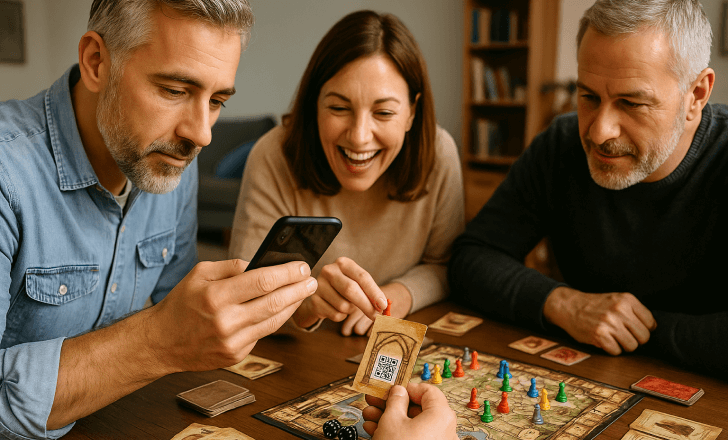
What’s next for QR codes in board games?
As the line between physical and digital continues to blur, QR codes are poised to become more than just links; they’ll act as portals to layered, dynamic game experiences. Future developments may include AI-generated content that adapts to your gameplay style, creating unique scenarios or dialogue based on previous choices. This level of personalization can add depth and replayability that traditional components alone might struggle to deliver.
One exciting possibility is the creation of persistent game worlds that evolve over time. By scanning a QR code, players might unlock new missions, side quests, or challenges that reflect their progress across multiple sessions or entirely different games. Developers could begin to build connected universes where outcomes in one title subtly affect the starting conditions of another, offering a kind of narrative ecosystem rarely seen in tabletop design.
Moreover, the technology remains highly accessible. Unlike complex digital components or AR systems, QR codes require no special equipment; just a smartphone, a printed code, and a compelling idea. This low barrier to entry means indie developers and small studios can compete with larger publishers when it comes to innovation, creating more diversity and experimentation in the board game industry.
Should you use QR codes in your own board game design?
Whether or not to incorporate QR codes into your board game depends heavily on what you want your players to experience. If your aim is to keep setup and rule explanation minimal while maintaining depth, QR codes can act as powerful tools. For example, they can hold tutorial videos, mini-narratives, or advanced rule clarifications that would clutter the table if included in print. This allows your physical game to remain elegant and focused, while digital content enhances player engagement and depth without overwhelming new players.
QR codes are also useful for delivering expandable or modular content. You could launch your game with a base storyline, and then push new chapters, missions, or characters via scannable codes post-release. This not only breathes life into your game after publication but also builds a stronger relationship with your players. Updates, balance tweaks, or even seasonal content can be added without reprinting anything, just update what the code points to.
Additionally, QR integration gives your game a layer of flexibility that’s hard to match with analog tools alone. From unlocking immersive audio soundscapes to supporting accessibility through narrated text or translation, QR codes can help ensure your game is enjoyable by a wider audience. All of this can be achieved while still honoring the tactile, social nature of board gaming, making them not a gimmick, but a genuinely helpful design option that respects traditional gameplay.
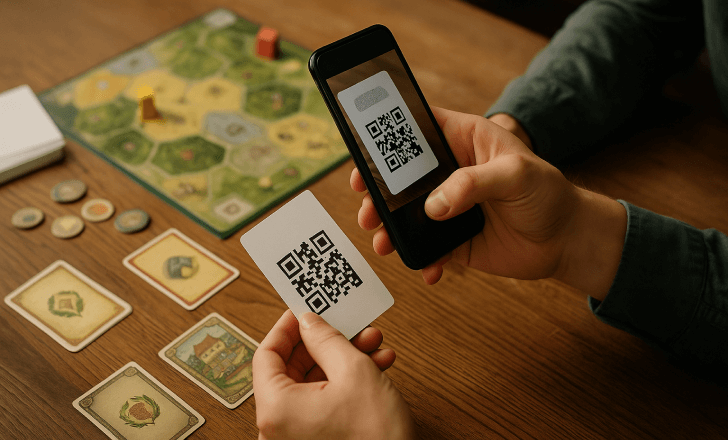
Are QR codes the future or just a trend in board games?
QR codes may seem trendy, but their utility makes them a lasting fixture. They solve real problems like accessibility, immersion, and flexibility without demanding high-end tech. For a medium that thrives on human connection and shared space, QR codes offer a bridge between tradition and innovation.
As players continue to seek deeper, smarter gameplay and immersive experiences , this little square may be here to stay.
